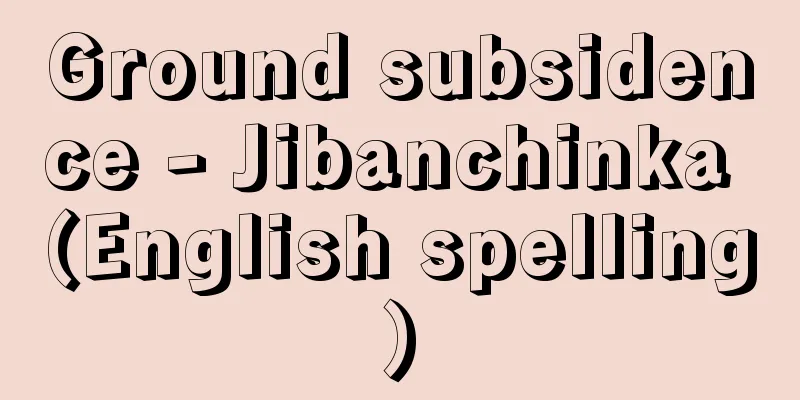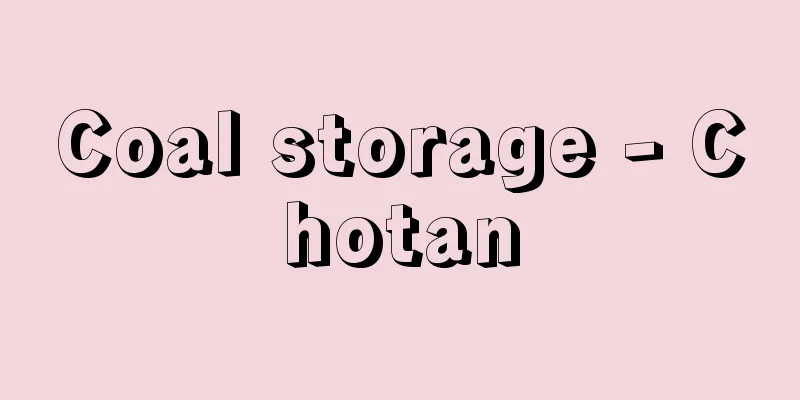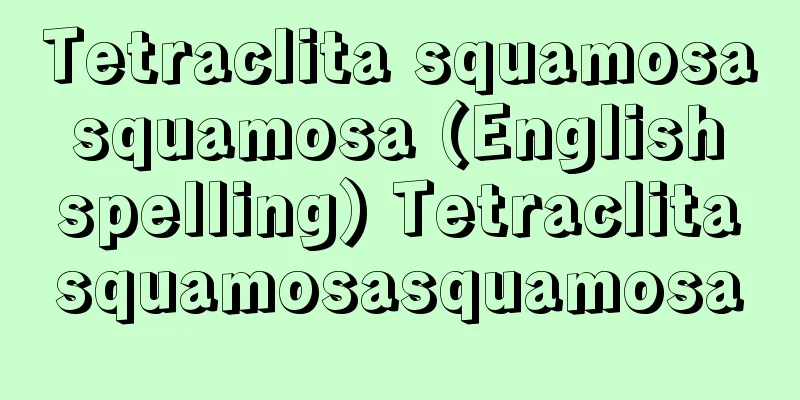Ground subsidence - Jibanchinka (English spelling)

|
It refers to the subsidence phenomenon caused by the inflow and outflow of materials from the surface layer of the earth's crust due to natural and human actions, and is distinct from displacement due to basin formation and earthquakes, i.e., crustal movement. There are clear differences between the two in terms of the amount and pattern of land subsidence. For example, the amount of subsidence due to basin formation is only 0.5 to 1 mm per year, or at most 3 mm, while land subsidence is tens or hundreds of times that amount. In addition, the deformation is always negative and irreversible, and recovery is almost impossible, the subsidence area is not very large, with the maximum extent being several hundred square kilometers, and continuous subsidence is caused by the contraction or deformation of strata several tens or even hundreds of meters underground. The inflow and outflow of materials mentioned at the beginning refers to the removal of liquids (groundwater, petroleum, natural gas, etc.) and solid materials, as well as the dehydration and contraction of organic soil and the volume reduction due to oxidative decomposition by the microorganisms contained therein. [Shizuo Shindo] Causes and mechanismsThe most typical cause and mechanism of land subsidence is the so-called consolidation subsidence caused by the withdrawal of fluids. Consolidation is a phenomenon in which a clay layer is compressed due to an increase in effective stress caused by a drop in the groundwater level of the aquifer adjacent to it. However, since the permeability of clay layers is generally very low, it takes a long time for the pore water to drain, and compression progresses only gradually. The consolidation phenomenon is characterized by progressing with a time lag. This type of land subsidence is often seen in coastal plains where thick layers of soft, unconsolidated strata such as alluvial and diluvial deposits have accumulated, and where groundwater has been actively used since ancient times. In Japan, typical areas of land subsidence include cities such as Tokyo, Sendai, Niigata, Yokohama, and Osaka, as well as the Nobi Plain and Saga Plain. Land subsidence caused by oil and natural gas extraction has the same mechanism, but the compacted layer is generally deep. Examples include natural gas fields in Niigata Prefecture, the Koto district of Tokyo, and Chiba Prefecture. Examples of land subsidence caused by oil extraction include the oil fields of Venezuela and the oil fields of Texas and California in the United States, with Long Beach in California being particularly famous. In some cases, the drainage of mine water during mine development causes the groundwater level to drop, resulting in the consolidation of unconsolidated layers near the mine. In Japan, examples of this are seen in the Joban coalfield (Fukushima Prefecture, Ibaraki Prefecture) and the Chikuho coalfield (Fukuoka Prefecture). In addition to this type of consolidation, there are also cases of land surface subsidence due to the collapse of tunnels and other structures. This is the same mechanism as subsidence caused by the collapse of underground cavities in limestone areas, and this type of subsidence is called a sinkhole. This type of subsidence has been reported in the aforementioned coalfields in Japan, and in the diamond mining areas of Alabama and Arizona in the United States and South Africa. In addition to these types of subsidence, a phenomenon called hydrocompaction can also be considered a broad form of land subsidence, but its mechanism is extremely unique. This is caused by the compression of highly porous eolian loess due to its water content. In the Santa Clara Valley of California, USA, there is an area where a type of mudflow deposit with similar properties is distributed, and it is said that the diversion of irrigation water there has caused a lot of damage, including the subsidence of farmland and the destruction of waterways. [Shizuo Shindo] Land Subsidence in JapanThe centers of land subsidence in Japan are urban areas such as Tokyo and Osaka, and the history of land subsidence is long, probably dating back to the end of the Meiji period or the early Taisho period, when mechanical development of groundwater began to become more common. The rapid subsidence of the ground in the Koto district of Tokyo's downtown area and other areas was quantitatively revealed by the results of revised leveling surveys conducted to investigate the displacement of the ground after the Kanto earthquake of 1923 (Taisho 12). In 1930 and 1931 (Showa 5 and 6), it was noted that the ground was already sinking at 15 to 17 centimeters per year. A similar phenomenon was also noted in Osaka City around 1933. Since then, various theories have been put forward regarding the cause of land subsidence, including (1) crustal movement, (2) drying shrinkage, (3) accelerated consolidation due to a drop in the groundwater level, (4) compressive load caused by structures, (5) tension due to earthquake vibrations, and (6) natural consolidation of the soil layer itself. It was around this time that the term "land subsidence" first appeared in print. It was research by Hirono Takuzo, Wadachi Kiyoo and others from 1939 to 1940 that first clarified, based on observation records using subsidence gauges and theoretical considerations, that the main cause of land subsidence is the drop in water levels due to groundwater pumping. From their research in western Osaka, they clarified that the rate of land subsidence -(dH/dt) is proportional to the difference between the standard groundwater pressure P0 and the current groundwater pressure P, as shown in the following equation, and announced the so-called accelerated consolidation theory (k is a proportionality constant).
It was not until the end of World War II, more than ten years later, that it was proven that groundwater pumping was the main cause of land subsidence.In other words, when industrial areas were destroyed by war damage and groundwater pumping for industrial use stopped, the groundwater level began to recover, and at the same time land subsidence rapidly decreased or even stopped.Even though the cause of subsidence was clearly proven in this way, groundwater use became active again during the postwar reconstruction period and the subsequent period of high economic growth, and land subsidence became even more severe. The flooding disaster caused by the Ise Bay Typhoon in 1959, which struck the coastal areas of the Nobi Plain, was significant as it led to a growing trend for restrictions on groundwater pumping and the strengthening of these restrictions in various regions. The typhoon's torrential rains and abnormally high tides hit the coastal areas of Ise Bay, where subsidence had been increasing and the area was at zero meters above sea level, resulting in an unprecedented disaster with 5,101 deaths and missing and damages totaling 85.2 billion yen. This drew the attention of the authorities in Tokyo and Osaka, which were experiencing similar subsidence conditions. This can be seen in the changes in groundwater levels and land subsidence in Tokyo, the restrictions on groundwater pumping and the recovery of groundwater levels, and the resulting reduction in the subsidence phenomenon. In Japan, natural gas is often referred to as water-soluble natural gas, and is found underground dissolved in groundwater. Therefore, in order to extract natural gas, the groundwater (natural gas brine) is pumped up and separated into gas and water at the surface. In other words, to extract one gram of gas, one or more gram of groundwater must also be pumped up. This is the reason for the severe land subsidence in natural gas-rich areas such as Niigata Prefecture and Chiba Prefecture. In order to mitigate this phenomenon, methods are being devised to separate the gas and groundwater underground and extract only the gas. As with the use of groundwater, various theories have been put forward as to the cause, but today almost no one denies the theory that it is due to the pumping of natural gas brine. This type of land subsidence in the Koto district of Tokyo, the Funabashi district of Chiba Prefecture, the Echigo Plain, and other areas has rapidly decreased due to strict regulations on gas extraction, including the abolition of such extraction, and in some areas is nearing an end. [Shizuo Shindo] Preventing land subsidenceLand subsidence is classified as one of the seven typical types of pollution in the Basic Law for the Environment (Law No. 91 of 1993), along with water pollution, air pollution, soil pollution, bad odors, noise, and vibration. In addition, the Industrial Water Law (Law No. 146 of 1956) and the Law Concerning the Regulation of Extraction of Groundwater for Buildings (Law No. 100 of 1962) have been enacted to prevent land subsidence, which regulate the extraction of groundwater in designated areas. Furthermore, local governments also implement their own ordinances in accordance with the actual conditions of their area. In addition to these legal provisions, advances in water-saving industrial technology and the use of reclaimed water have led to a reduction in the amount of groundwater pumped, and areas where land subsidence was once severe, such as Tokyo, Osaka, Nagoya, and Niigata, have seen a significant reduction or elimination of the problem. On the other hand, apart from these situations, there are also cases of land subsidence caused by increased use of groundwater for agricultural purposes during drought years and increased use of groundwater to melt snow in snowy areas. Examples of the former are the Northern Kanto region, and examples of the latter include Minamiuonuma City in Niigata Prefecture. In these areas, if the groundwater level drops beyond a certain level, measures are taken to prevent land subsidence, such as issuing a warning and restricting pumping. As the saying goes, "natural disasters come when we least expect them," and there is no guarantee that the land subsidence that appears to have subsided for now will not reoccur. This is because we cannot deny the possibility that new forms of land subsidence will occur in the future due to the progress of large-scale underground development and the boom in urban hot springs. [Shizuo Shindo] "Groundwater and Land Subsidence Countermeasures," edited by the Environment Agency's Water Quality Protection Bureau (1978, Hakua Shobo)" ▽ "Land Subsidence and Groundwater in the Nobi Plain," edited by the Tokai Three Prefectures Land Subsidence Research Committee (1985, Nagoya University Press)" ▽ "Illustrated Guide to Us and the Environment 4: Soil Contamination and Land Subsidence," edited and published by Obunsha (1987) ▽ "Land Subsidence and Its Countermeasures," edited by the Land Subsidence Prevention Measures Study Group and supervised by the Planning Division of the Environment Agency's Water Quality Protection Bureau (1990, Hakua Shobo)" ▽ "Land Subsidence," by Shibasaki Tatsuo (Sanseido Shinsho) [Reference items] | | | | | | | | | | | | | | |Crustal | | | | | | |Source: Shogakukan Encyclopedia Nipponica About Encyclopedia Nipponica Information | Legend |
|
自然的、人為的作用による地殻表層部の物質の出入りに起因する沈降現象をさし、造盆地運動や地震による変位、つまり地殻変動とは区別される。地盤の沈降量や沈降パターンのうえでも両者の間には明瞭(めいりょう)な相違がある。たとえば、造盆地運動による沈降量が年当り0.5~1ミリメートルか多くても3ミリメートル程度にとどまるのに対して、地盤沈下はその数十倍ないし数百倍にも達する。また、変動がつねに負で非可逆的であり、回復することはほとんどないこと、沈下地域はあまり広くなく、最大の広がりは数百平方キロメートルであること、継続的な沈下は地下数十メートルか深くても数百メートルの地層の収縮または変形によって生ずること、などがあげられる。最初に述べた物質の出入りとは、液体(地下水、石油、天然ガスなど)や、固体物質の取り出しのほかに、有機質土の脱水収縮、および、それらに含まれる微生物の酸化分解による体積減少などをさす。 [新藤静夫] 原因と機構地盤沈下の原因および機構のなかでもっとも代表的なものは、流体の取り出しに起因するいわゆる圧密による沈下である。圧密とは、粘土層がそれに接する帯水層の地下水位の低下によって生じた有効応力の増大により圧縮される現象であるが、一般に粘土層の透水性はきわめて小さいため、間隙(かんげき)水が排出するのに長時間を要し、圧縮は徐々にしか進まない。圧密現象はこのように時間の遅れを伴いつつ進行するのが特徴である。このようなタイプの地盤沈下は沖積層や洪積層のように軟弱な未固結の地層が厚く堆積(たいせき)している海岸平野で、かつ昔から地下水利用が盛んに行われてきたような所で多くみられる。日本では東京をはじめ仙台、新潟、横浜、大阪などの都市のほか、濃尾(のうび)平野、佐賀平野が代表的な地盤沈下地域といえる。 石油や天然ガスの採取に伴う地盤沈下も機構上は同じであるが、圧密層は一般に深い。新潟県、東京都の江東(こうとう)地区、千葉県などの天然ガス田がその例としてあげられる。石油採取によるものとしては、外国ではベネズエラの油田地帯やアメリカのテキサス州やカリフォルニア州などの各油田地帯があげられるが、とりわけカリフォルニア州のロング・ビーチが有名である。 炭鉱の開発の際の坑内水の排除によって地下水位が下がり、炭鉱付近の未固結層が圧密する例もあり、日本では常磐(じょうばん)炭田(福島県、茨城県)、筑豊(ちくほう)炭田(福岡県)でその例がみられる。鉱山開発による沈下のなかにはこのような圧密によるもの以外に、坑道などの陥没によって地表面が沈下する例もある。これは石灰岩地帯の地下の空洞の陥没による沈下と機構は同じで、このようなタイプの沈下をシンクホールsinkholeとよんでいる。日本では先の炭田地帯、外国ではアメリカのアラバマ州やアリゾナ州、南アフリカ共和国のダイヤモンド採掘地などでこの種類の沈下の報告がある。これらの沈下のほかに、ハイドロコンパクションhydrocompactionとよばれる現象も広義の地盤沈下といえるが、機構上はきわめて特殊である。これは高間隙の風成のレスloess(黄土)などが含水することにより圧縮するものである。アメリカのカリフォルニア州のサンタ・クララ谷には、同様の性質を示す一種の泥流堆積物が分布する所があり、灌漑(かんがい)水の導水によって、農地が沈降したり、水路が破壊されたりして多くの被害が生じているという。 [新藤静夫] 日本の地盤沈下日本における地盤沈下の中心は東京や大阪などの都市域で、その歴史も古く、おそらく機械力による地下水の開発が盛んになりかけてきた明治末期から大正初期にまでさかのぼる。 東京下町の江東地区などの地盤が激しく沈下していることが量的に明らかにされたのは、1923年(大正12)の関東地震の地盤の変位を調べる目的で行われた水準測量の改測の結果によるといわれ、1930、1931年(昭和5、6)にはすでに年間15~17センチメートルも沈下していることが指摘された。1933年ころ大阪市でも同様の現象が指摘されている。このとき以来、地盤沈下の原因については種々の説が打ち出され、(1)地殻変動、(2)乾燥収縮、(3)地下水位低下による圧密加速、(4)構造物による荷重圧縮、(5)地震の振動による緊迫、(6)土層自体の自然圧密などの諸説が論議された。「地盤沈下」ということばが紙上に現れたのもこのころである。 地下水の揚水による水位低下が地盤沈下の主原因であることを、沈下計による観測記録とその理論的考察のうえから初めて明らかにしたのは、1939~1940年にかけての広野卓蔵(ひろのたくぞう)、和達清夫(わだちきよお)などの研究であった。彼らは西大阪での研究から、次式に示したように地盤沈下速度-(dH/dt)は、標準地下水圧P0と現在地下水圧Pの差に比例することを明らかにし、いわゆる圧密加速説を発表した(kは比例定数)。
地下水の揚水が地盤沈下の主原因であることが実証されたのは、それから10年以上を経た第二次世界大戦の終戦後のことである。すなわち、戦災により工業地帯が壊滅し、工業用水としての地下水の揚水が止まることにより、地下水位が回復に向かい、同時に地盤沈下が急減し、あるいは停止したのである。沈下の原因がこのように明確に実証されたにもかかわらず、戦後の復興期とそれに続く高度経済成長の時代に入ってふたたび地下水の利用が盛んになり、地盤沈下も激化の度を加えるに至った。 地下水の揚水規制の気運が高まり、これが各地で強化されるようになった契機として、濃尾平野臨海部を襲った1959年(昭和34)の伊勢湾台風(いせわんたいふう)による浸水災害は大きな意味をもつといえる。すなわち、それまで沈下の度を加え、いわゆるゼロメートル地帯が広がっていた伊勢湾沿岸部に、台風による豪雨と異常高潮が襲い、実に死者・行方不明者あわせて5101人、被害総額852億円という未曽有(みぞう)の災害をもたらしたことが、同じような地盤沈下の状況にあった東京、大阪の当局の注意を喚起したといえる。東京における地下水位と地盤沈下の推移、地下水揚水規制と地下水位の回復、それに伴う地盤沈下現象の低減などにそのことがうかがえる。 日本における天然ガスは、多くの場合、水溶性天然ガスと称し、地下にあって地下水に溶けた状態で賦存しているものが多い。そのため、天然ガスを採取するためには、この地下水(天然ガス鹹水(かんすい))を揚水し、地表でガスと水に分離する方法がとられる。すなわち、ガスを1採取するとすれば、地下水も1かそれ以上揚水しなければならない。新潟県や千葉県などの天然ガス地帯での激しい地盤沈下は、このような原因によるものである。なおこのような現象を軽減するため、ガスと地下水を地下で分離し、ガスだけを取り出すくふうもなされている。 地下水利用の場合と同じように、原因について多様の説が出されてきたが、今日天然ガス鹹水の揚水によるとする説を否定する者はほとんどいないといってよい。東京都江東地区、千葉県船橋地区、越後(えちご)平野などでのこの種の地盤沈下は、廃止を含む厳しいガス採取規制によって急減し、また一部では終息に近づいている。 [新藤静夫] 地盤沈下の防止地盤沈下は環境基本法(平成5年法律第91号)において水質汚濁、大気汚染、土壌汚染、悪臭、騒音、振動とともに典型7公害として位置づけられている。また地盤沈下を防止するための法律として工業用水法(昭和31年法律第146号)および建築物用地下水の採取の規制に関する法律(昭和37年法律第100号)が制定されており、これにより地域を指定して地下水の採取が規制されている。さらに地方自治体においても地域の実情に即した形で独自の条例が施行されている。 このような法整備に加えて、節水型工業技術の進歩や再生水の利用による地下水揚水量の軽減が進み、東京、大阪、名古屋、新潟などのかつての地盤沈下激甚地域は著しく縮小し、または終息をみている。 一方このような状況とは別に干魃(かんばつ)年における農業用水としての地下水利用の増大や、積雪地域の消雪のための地下水利用の増大による地盤沈下の進行もみられる。前者の例として北関東地域、後者の例として新潟県南魚沼(みなみうおぬま)市などがあげられる。これらの地域では地下水位低下がある一定量を超えた場合、警告を発して揚水を制御するといった措置をとり、地盤沈下の未然防止につとめている。 「天災は忘れたころにやってくる」ということばの通り、いま終息しているようにみえている地盤沈下が再発しないという保証はない。将来的には大規模地下開発の進行や都市温泉ブームによって新たな形の地盤沈下が発生する可能性も否定できないからである。 [新藤静夫] 『環境庁水質保全局編『地下水と地盤沈下対策』(1978・白亜書房)』▽『東海三県地盤沈下調査会編『濃尾平野の地盤沈下と地下水』(1985・名古屋大学出版会)』▽『旺文社編・刊『図説・私たちと環境4/土の汚染と地盤沈下』(1987)』▽『地盤沈下防止対策研究会編、環境庁水質保全局企画課監修『地盤沈下とその対策』(1990・白亜書房)』▽『柴崎達雄著『地盤沈下』(三省堂新書)』 [参照項目] | | | | | | | | | | | | | | | | | | | | | |出典 小学館 日本大百科全書(ニッポニカ)日本大百科全書(ニッポニカ)について 情報 | 凡例 |
>>: Ground Survey - Jibanchosa
Recommend
oar
...a tool for rowing a boat. There are two types:...
Parsa (English spelling)
…An alternative name for Iran that has been used ...
Golgi apparatus
It is one of the intracellular organelles in which...
molar
… The fourth change is the change in homodontia, ...
Isoquant
A curve that shows the possibility of technologica...
Red-eared dragon - Red-eared dragon
...Briar pipes are made from the roots of E. arbo...
Concourse
〘noun〙 (concourse) A wide passageway that also ser...
Candela (candela)
...A type of oil lamp. It is a corrupted form of ...
International Federation of Free Teachers Union
… Internationally, the Educational Workers Intern...
Paolozzi, E. (English spelling)
…After the war, Britain also produced pop art, st...
Cassia glanca (English spelling)
…[Mitsuru Hotta] [Aya Nitta]. … *Some of the term...
Duke of Gandia
...In fact, she is well known to locals as a phil...
Ihou (Ihou)
〘Noun〙① A robe for morning wear in the color corre...
Equitable Society
...The Roman Empire's burial funds, the sickn...
Pridi Phanomyong
1900‐83 Thai politician. Royal name Luang Praditma...









